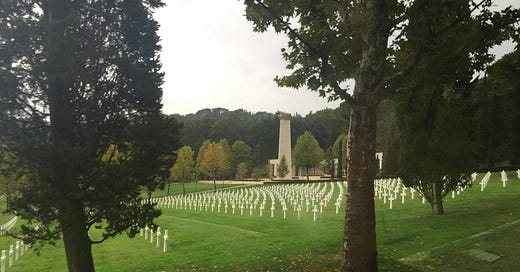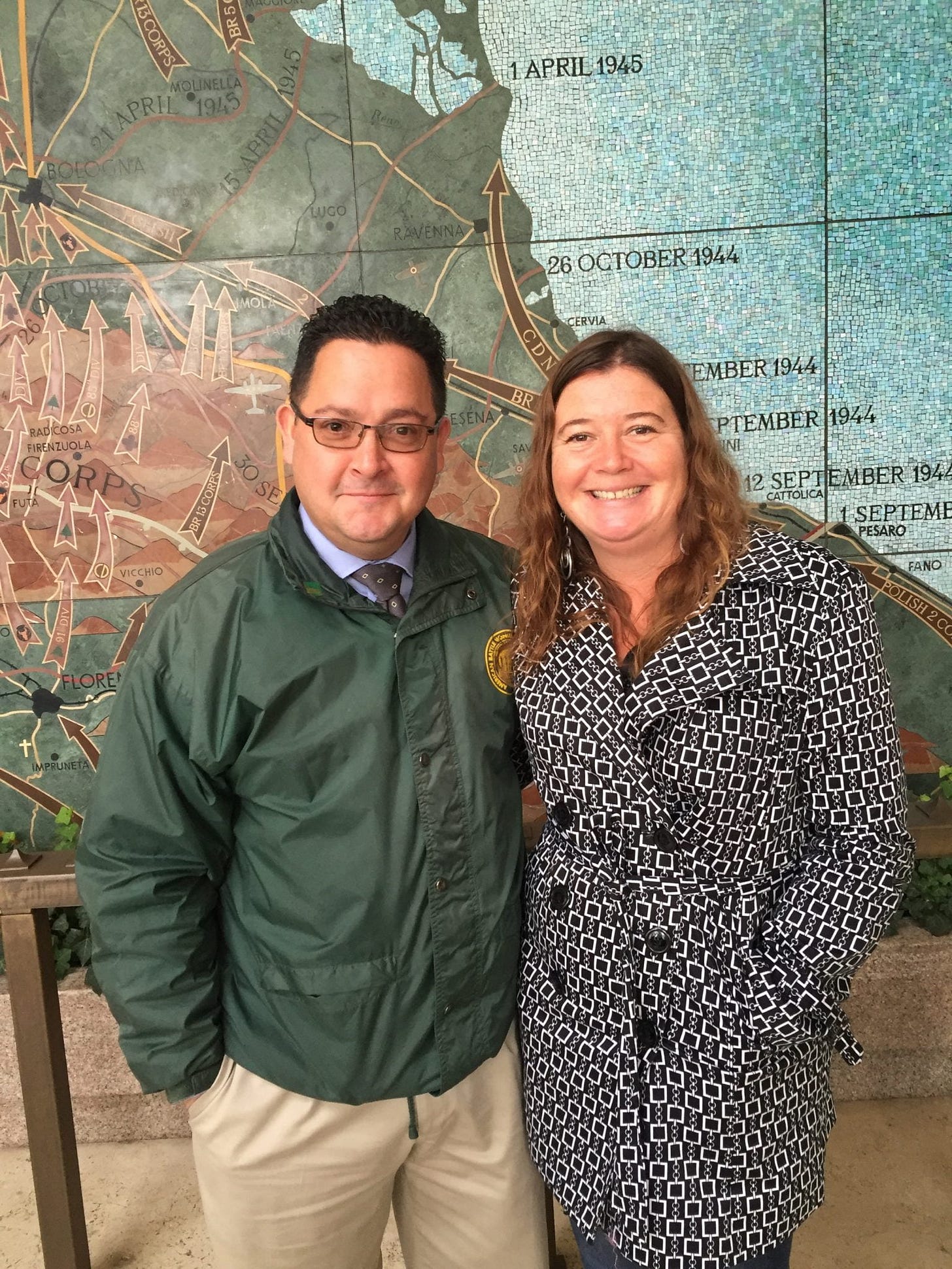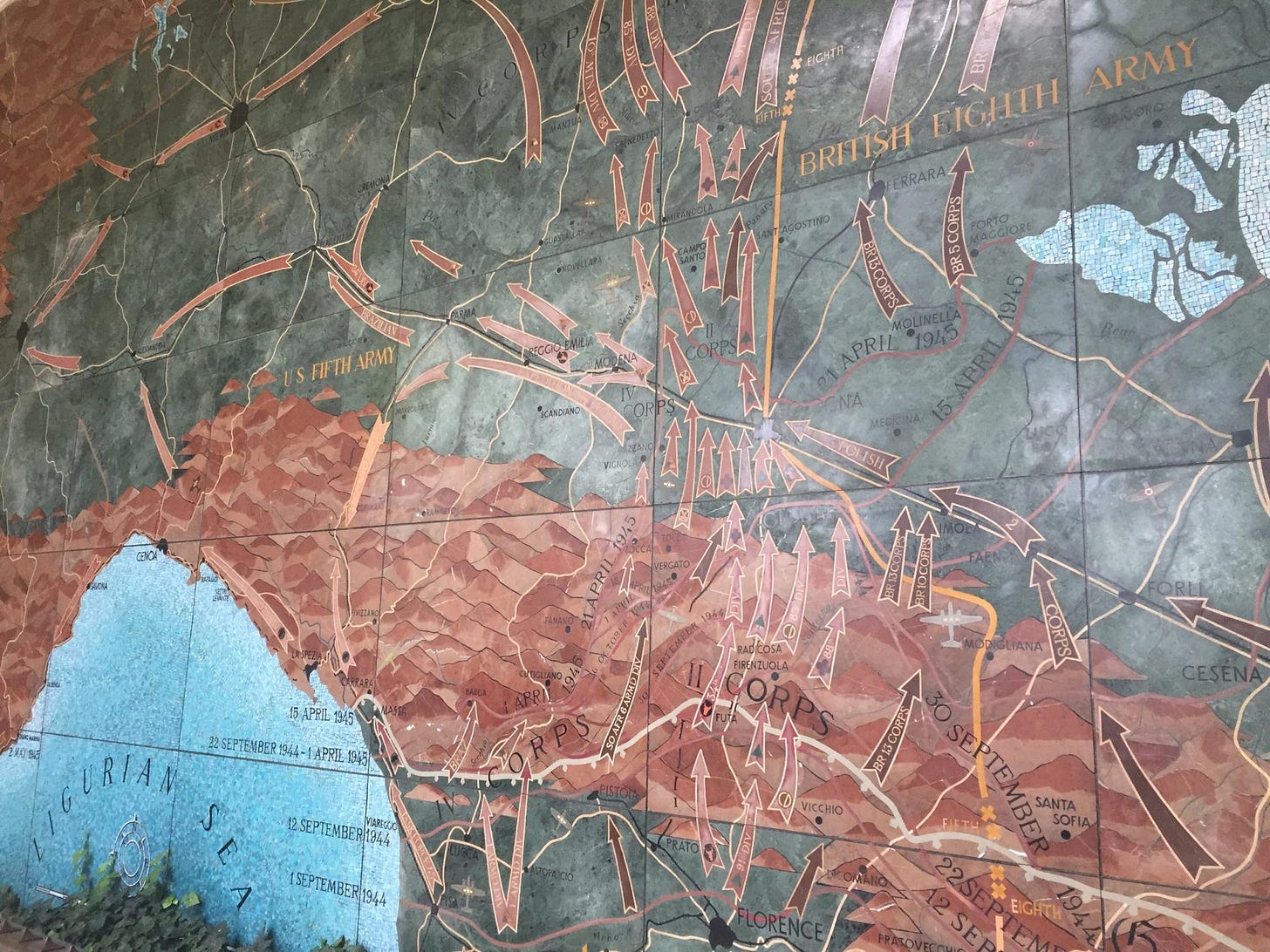Remembering Veterans in Italy this Festa della Liberazione ❤️🇮🇹
Reflections on WWII, the power of memory, and stories we mustn't forget.
Today, April 25, is Festa della Liberazione in Italy; Liberation Day - the anniversary of the end of fascist rule in Italy in 1945. As such I wanted to share this post I wrote some years back for my website - I re-read it recently and felt it deserved to be shared again to honor the memories of everyone who fought and sacrificed their lives for Italy’s freedom in WW2.
When I began my career as a tour guide more than 15 years ago, it was fairly normal for me to have veterans of World War II on my tours from time to time. It’s been some years since I’ve had one, and as time passes, even my own family members who were alive at the time of WWII are mostly gone.
My British grandmother and grandfather both served in the Royal Air Force, which is where they met and married. My grandmother’s last husband was an American who served at D-Day in Normandy, something he spoke of constantly as if it were only months ago.
Unfortunately, all of them died before I was of an age to understand or be interested in their experiences. I was given their medals by my uncle in Ireland, but I have no stories to go along with them and give them meaning.
I regret that I was unable to hear my family’s stories, so I’ve become very interested in listening to the stories of others that I meet. I remember several years ago a tour member that was a veteran, back in Italy for the first time since the war. He was traveling with his children and had come to celebrate a family reunion of sorts. He was an airman and was involved at the battle of Monte Cassino, a battle that is infamous for massive casualties, many of them civilians.
On the day that we left Naples for Rome, his son asked if I would mind passing the microphone to him so that he could tell the story of the battle as we drove by. Of course I agreed, and with trembling hands he took the mic. The story was not long, but the grief was so thick, his sadness for his comrades who were lost and for those who he himself had killed was overwhelming for everyone on the bus. It put a face on war that I’d never seen before, especially as this man had not been to that place for more than 50 years. I don’t think I’ll ever forget that day.
I'd love for you to join our weekly chat where we share stories and reflections inspired by travel experiences like these.
Even if the struggle to take Italy was a major part of the Allied effort at the end of the war, there are only a few spots to go these days and learn about it. There are a few cemeteries and a couple of good museums, such as in Catania in Sicily and Anzio near Rome.
On a past tour I paid a visit to the American Cemetery outside of Florence, which I hadn’t done in some years. I used to always take people there if I had a WWII vet in the group. I got out of the habit of taking my groups since the generation that lived through the war doesn’t travel much anymore. I had forgotten how beautiful and moving it is. It is well worth the visit.
On my visit, we were greeted by one of the two main custodians, a man named (quite appropriately) Angel - pictured left above. The cemetery is run by retired American servicemen and is technically considered American soil. Working as a custodian is a fairly sought-after position, and the men who care for the cemetery are passionate about it.
Our bus entered the grounds, which cover about 70 acres, and drove to the main building that houses the chapel and memorial wall. The array of crosses fanning out across the grass was so peaceful and organized, a contrast with the Italian traffic on the adjacent highway. Angel spoke to us for about a half hour, but it was clear that he could have spoken more if there had been time. We heard about the Allied troop movements, beginning with the invasion of Sicily and Operation Husky, the Battle of Rome, and then about the struggles from Rome up to the Alps. This last push, from the very end of the war, is where the majority of interred soldiers came from.
A large tile mosaic on the opposite side from the chapel showed the troop movements with arrows and symbols to explain those perilous last gasps of the war. Between the chapel and the tile mosaic wall was a memorial wall with the names of missing soldiers. A few names had a small metal dot next to them. Those are the soldiers who have been found since the cemetery was opened in the 1960’s. I thought that was strange, so I asked when the most recent recovery of remains occurred. To my surprise, the answer was only a few years ago, maybe 7 or so, if I remember correctly.
The remains of an airman had been found near Genova, unearthed during excavation at a construction site. After identifying the remains, they were returned to the family. The cemetery staff wish that all of the names on that wall could have the same story, and it seems that even now it could be possible.
Angel’s passion is for investigating the soldiers lives, finding letters home and personal effects to help to illustrate their individual stories. He has collected quite a bit of information in the short time he’s been there. As time passes, fewer family members are left to visit the graves. Some soldiers buried there have never been visited by family or friends.
Angel feels that documenting their personal information and keeping their life stories alive is important so that they all can be remembered, even if nobody who personally knew them is around to do the remembering.
When we were done listening to him speak, he asked us all to stroll amongst the graves. The headstones are arranged geometrically on a perfect grass lawn, and our bus driver was scandalized that we would walk on the grass. In Italy grass is considered a plant, in many parks it is illegal to walk on it. But this cemetery is American soil and we were encouraged to walk on the grass.
The walk on the grass had a purpose. What Angel asked us to do was to randomly select a grave to visit. To look at the name. To spend a minute remembering that person and thanking them for their sacrifice. Everyone did as they were asked, and few left with dry eyes. The American Cemetery is well worth a visit if you are anywhere near Florence. Even if you know little about the history of the war, it is a great experience chatting with the custodians and walking among the graves, reading the names aloud.
For more information about the American Cemetery in Florence, visit their website: https://www.abmc.gov/cemeteries-memorials/about-florence-american-cemetery/
Interested in learning more about the liberation of Italy at the end of WWII? I recently read an excellent book with my son, The Liberator by Alex Kershaw. It is a true story of one man and his remarkable survival through the major battles in Italy, up to the liberation of Dachau concentration camp. My son and I highly recommend it, it’s a quick and fascinating read. You can find it HERE.











Thanks, Sarah! I had to restack!
Thanks for sharing this Sarah. Two of Jim’s uncles along with his dad were combat veterans of WWII. One of the uncles was in the invasion of Italy. We believe he was part of the landing in Sicily and then proceeded to Naples. The other uncle was in Southeast Asia; Jim remembers hearing references to Borneo and Thailand. My dad was an Army corpsman in the European theater. My father-in-law was in the invasion of Okinawa. As we go forward in life, it is important to carry the memories of past generations and honor their achievements. The accomplishments of WWII are especially significant now, given the new threats our nation is facing. “One if by land, two if by sea . . .”